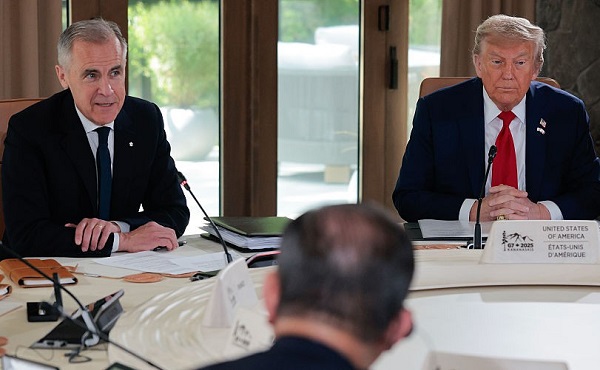Energy
House votes to block China from buying oil from US reserves
By Matthew Daly in Washington
WASHINGTON (AP) — The Republican-controlled House on Thursday voted to block oil from the country’s emergency stockpile from going to China.
The bill, one of the first introduced by the new GOP majority, would prohibit the Energy Department from selling oil from the Strategic Petroleum Reserve to companies owned or influenced by the Chinese Communist Party. It passed easily, 331-97, with 113 Democrats joining unanimous Republicans in support.
Rep. Cathy McMorris, R-Wash., the new head of the House Energy and Commerce Committee, said the bill would help end what she called President Joe Biden’s “abuse of our strategic reserves.”
Biden withdrew 180 million barrels from the strategic reserve last year in a bid to halt rising gasoline prices amid production cuts by OPEC and a ban on Russian oil imports following Moscow’s invasion of Ukraine. The monthslong sales brought the stockpile to its lowest level since the 1980s. The administration said last month it will start to replenish the reserve now that oil prices have gone down.
McMorris Rodgers accused Biden of using the reserve to “cover up his failed policies” that she said are driving up energy prices and inflation.
“Draining our strategic reserves for political purposes and selling it to China is a significant threat to our national and energy security. This must be stopped,” McMorris Rodgers said.
The measure is the first in a series of GOP proposals aimed at “unleashing American energy production,” McMorris Rodgers said as Republicans seek to boost U.S. production of oil, natural gas and other fossil fuels.
“There’s more to come. This is just the beginning,” she said.
Democrats, including former Energy and Commerce Chairman Frank Pallone of New Jersey, said Republicans were trying to fix a problem of their own making. China is among numerous potential adversaries that buy U.S. oil after the GOP-led Congress lifted an export ban in 2015.
“If Republicans were serious about addressing this issue, they would have brought forward a bill that banned all oil exports to China,” Pallone said, adding that sales from the strategic reserve amounted to about 2% of U.S. oil sold to China last year.
“If we truly want to address China using American oil to build its reserves, let’s actually take a serious look at that, rather than skirt around the issue because Republicans are scared of Big Oil’s wrath,” Pallone said.
The current process allows for crude oil sales from the strategic reserve to companies that make the highest offer, which includes U.S. subsidiaries of foreign oil companies, and they could then export that crude oil overseas. Last year, millions of barrels of oil from the U.S. reserves wound up being exported to China, including to a subsidiary of China’s state-run oil company, Sinopec.
The Energy Department said in a statement Thursday that Biden “rightly authorized emergency use” of the strategic reserve, also known as the SPR, to address supply disruptions and “provide relief to American families and refineries when needed the most.”
The Treasury Department estimates that release of oil from the emergency stockpile lowered prices at the pump by up to 40 cents per gallon. Gasoline prices, meanwhile, averaged about $3.27 per gallon on Thursday, down from just over $5 per gallon at their peak in June, according to the AAA auto club.
“By law we are required to select the highest value bid to ensure the best return for taxpayers, and since 2017 the vast majority of oil sold from the reserve is sold to American entities,” the Energy Department said. Over the last five years, less than 3% of oil from the strategic reserve has gone to China, officials said.
The House bill now goes to the Democratic-controlled Senate. Sen. John Barrasso, R-Wyo., has introduced a similar measure.
Economy
Ottawa’s muddy energy policy leaves more questions than answers

From the Fraser Institute
Based on the recent throne speech (delivered by a King, no less) and subsequent periodic statements from Prime Minister Carney, the new federal government seems stuck in an ambiguous and ill-defined state of energy policy, leaving much open to question.
After meeting with the premiers earlier this month, the prime minister talked about “decarbonized barrels” of oil, which didn’t clarify matters much. We also have a stated goal of making Canada the world’s “leading energy superpower” in both clean and conventional energy. If “conventional energy” includes oil and gas (although we’re not sure), this could represent a reversal of the Trudeau government’s plan to phase-out fossil fuel use in Canada over the next few decades. Of course, if it only refers to hydro and nuclear (also forms of conventional energy) it might not.
According to the throne speech, the Carney government will work “closely with provinces, territories, and Indigenous Peoples to identify and catalyse projects of national significance. Projects that will connect Canada, that will deepen Canada’s ties with the world, and that will create high-paying jobs for generations.” That could mean more oil and gas pipelines, but then again, it might not—it might only refer to power transmission infrastructure for wind and solar power. Again, the government hasn’t been specific.
The throne speech was a bit more specific on the topic of regulatory reform and the federal impact assessment process for energy projects. Per the speech, a new “Major Federal Project Office” will ensure the time needed to approve projects will be reduced from the currently statutory limit of five years to two. Also, the government will strike cooperation agreements with interested provinces and territories within six months to establish a review standard of “one project, one review.” All of this, of course, is to take place while “upholding Canada’s world-leading environmental standards and its constitutional obligations to Indigenous Peoples.” However, what types of projects are likely to be approved is not discussed. Could be oil and gas, could be only wind and solar.
Potentially good stuff, but ill-defined, and without reference to the hard roadblocks the Trudeau government erected over the last decade that might thwart this vision.
For example, in 2019 the Trudeau government enacted Bill C-48 (a.k.a. the “Tanker Ban Bill”), which changed regulations for large oil transports coming and going from ports on British Columbia’s northern coast, effectively banning such shipments and limiting the ability of Canadian firms to export to non-U.S. markets. Scrapping C-48 would remove one obstacle from the government’s agenda.
In 2023, the Trudeau government introduced a cap on Canadian oil and gas-related greenhouse gas emissions, and in 2024, adopted major new regulations for methane emissions in the oil and gas sector, which will almost inevitably raise costs and curtail production. Removing these regulatory burdens from Canada’s energy sector would also help Canada achieve energy superpower status.
Finally, in 2024, the Trudeau government instituted new electricity regulations that will likely drive electricity rates through the roof, while ushering in an age of less-reliable electricity supply: a two-handed slap to Canadian energy consumers. Remember, the throne speech also called for building a more “affordable” Canada—eliminating these onerous regulations would help.
In summation, while the waters remain somewhat muddy, the Carney government appears to have some good ideas for Canadian energy policy. But it must act and enact some hard legislative and regulatory reforms to realize the positive promises of good policy.
Alberta
Unified message for Ottawa: Premier Danielle Smith and Premier Scott Moe call for change to federal policies

United in call for change: Joint statement |
“Wednesday, Alberta’s and Saskatchewan’s governments came together in Lloydminster to make a unified call for national change.
“Together, we call for an end to all federal interference in the development of provincial resources by:
- repealing or overhauling the Impact Assessment Act to respect provincial jurisdiction and eliminate barriers to nation-building resource development and transportation projects;
- eliminating the proposed oil and gas emissions cap;
- scrapping the Clean Electricity Regulations;
- lifting the oil tanker ban off the northern west coast;
- abandoning the net-zero vehicle mandate; and
- repealing any federal law or regulation that purports to regulate industrial carbon emissions, plastics or the commercial free speech of energy companies.
“The federal government must remove the barriers it created and fix the federal project approval processes so that private sector proponents have the confidence to invest.
“Starting with additional oil and gas pipeline access to tidewater on the west coast, our provinces must also see guaranteed corridor and port-to-port access to tidewater off the Pacific, Arctic and Atlantic coasts. This is critical for the international export of oil, gas, critical minerals, agricultural and forestry products, and other resources. Accessing world prices for our resources will benefit all Canadians, including our First Nations partners.
“Canada is facing a trade war on two fronts. The People’s Republic of China’s ‘anti-discrimination’ tariffs imposed on Canadian agri-food products have significant impacts on the West. We continue to call on the federal government to prioritize work towards the removal of Chinese tariffs. Recently announced tariff increases, on top of pre-existing tariffs, by the United States on Canadian steel and aluminum products are deeply concerning. We urge the Prime Minister to continue his work with the U.S. administration to seek the removal of all tariffs currently being imposed by the U.S. on Canada.
“Alberta and Saskatchewan agree that the federal government must change its policies if it is to reach its stated goal of becoming a global energy superpower and having the strongest economy in the G7. We need to have a federal government that works with, rather than against, the economic interests of Alberta and Saskatchewan. Making these changes will demonstrate the new Prime Minister’s commitment to doing so. Together, we will continue to fight to deliver on the immense potential of our provinces for the benefit of the people of Saskatchewan and Alberta.”
-

 Business2 days ago
Business2 days agoCarney praises Trump’s world ‘leadership’ at G7 meeting in Canada
-

 Business1 day ago
Business1 day agoThe CBC is a government-funded giant no one watches
-

 conflict2 days ago
conflict2 days agoTrump leaves G7 early after urging evacuation of Tehran
-

 conflict1 day ago
conflict1 day agoMiddle East clash sends oil prices soaring
-

 Business2 days ago
Business2 days agoTrump family announces Trump Mobile: Made in America, for America
-

 Crime2 days ago
Crime2 days agoUK finally admits clear evidence linking Pakistanis and child grooming gangs
-

 Also Interesting2 days ago
Also Interesting2 days agoHow to Use Bonuses at Magius Casino and Similar Websites
-

 conflict1 day ago
conflict1 day agoTrump Threatens Strike on Khamenei as Israel Pounds Iranian Military Command






